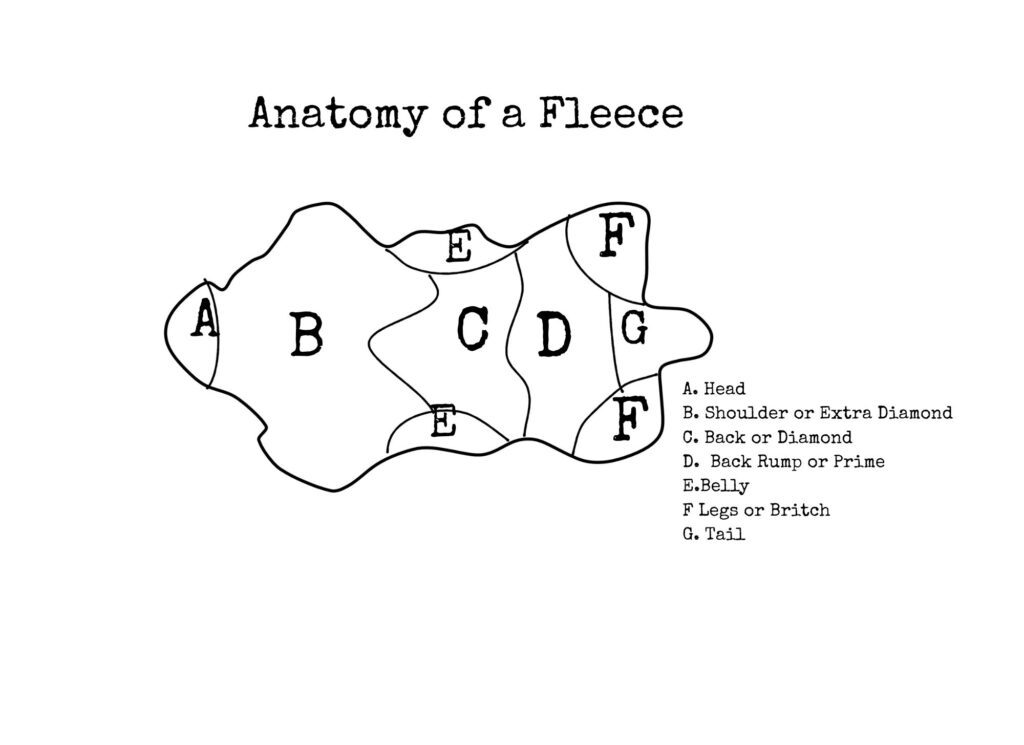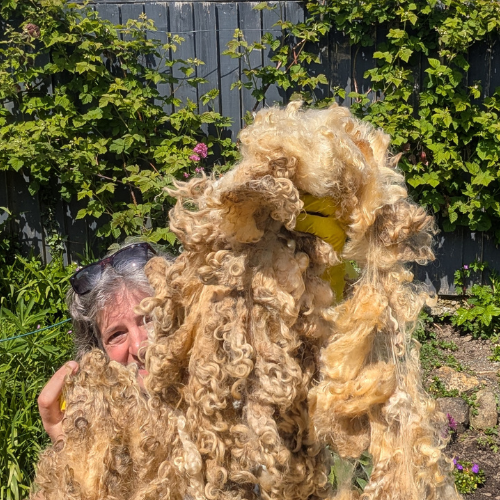New Hand Spinners Glossary of Raw Fleece Terms
What is Raw Fleece?
Raw Fleece is straight off the sheep. No washing, no processing—just pure, woolly goodness. Sometimes also called “in the grease” if it still contains its natural oils.
Why Hand Spinners Should Work with Raw Fleece?
There’s something incredibly grounding about working with raw fleece. It connects you to the land, to the animal, and to the age-old tradition of making yarn, start to finish. For hand spinners and natural dyers, getting to know raw fleece isn’t just a useful skill; it’s an absolute joy.
Raw fleece can feel a little intimidating at first. The smell, the grease, and the sheer amount of wool can be a bit much if you’re used to shop-bought roving. But once you know what you’re looking at (and what you’re looking for), it becomes a treasure trove of potential. You can choose how it’s processed, which parts you want to spin, and which you might end up on the garden or in the compost bin. Plus, it’s much more economical and sustainable.
In this post, I’ll walk you through the 10 key takeaways from my video “Raw Fleece for Beginners” perfect if you’re just starting on your hand spinning journey or curious about trying working with unprocessed fleece.

Learn the Lingo
From raw fleece to suant, there are quite a few new terms to get your head around. Knowing what they mean makes buying and processing fleece so much easier.
1. Let’s Talk Lanolin
That lovely waxy stuff is lanolin, and it’s what keeps sheep waterproof. It’s great for your hands (unless you’re allergic), and is removed during washing or scouring.
2. Avoid Second Cuts
These are little short, stubby bits of fleece where the shearer’s gone over the same spot twice. Not ideal for spinning they tend to clump and pill.
3. VM (Vegetable Matter) Happens
Bits of straw, grass seed, and the occasional hedge—sheep pick it all up. A bit is fine, but too much can be annoying to clean out.
4. Suant Fermentation is Brilliant
This old-school method uses rainwater and the sheep’s natural sweat to create a gentle, effective soap. Leave your fleece to soak for a couple of weeks, and it’ll clean itself naturally. Magic!
5. Crimp and Staple Length Matter
Crimp is the curliness of the wool, and staple length is how long each fibre is. Different breeds and parts of the fleece give you different textures—Lincoln Longwool, for example, has glorious long staples.
6. Know Your Fleece Anatomy
From the soft diamond on the shoulders to the coarser belly and tail, every part of the fleece has its place and its potential. Not all of it is good for spinning, but much of it has its uses.
Anatomy of a Fleece

7. shearling First Time’s the Charm
A shearling is the fleece from a lamb’s very first shearing, usually when they’re around a year old. It tends to be soft, fine, and sometimes shorter in staple length, but it’s lovely to spin if you get a good one. A real treat for delicate yarn projects.
8. Souring
You can go traditional with a fermentation bucket, or do a big batch scouring with detergent and heat. It depends on how precious you are about your fleece and how much time you have. To scour wool, gently wash it in hot water with a wool-safe detergent to remove lanolin, dirt, and debris—being careful not to agitate it, which can cause felting.
9. Skirting
Skirting is the process of removing the rough, poopy, or unusable bits of fleece before you start. You will often buy fleece that has already been skirted when the animal was sheared.
10. Kemp Kemp refers to the coarse, wiry hairs that some breeds have. Not great for next-to-skin wear but fab for hardwearing items like peg loom rugs.
Conclusion
Working with raw fleece might be a bit of a learning curve, but it’s so worth it. You’ll get to know your fibre inside and out, and there’s a real satisfaction in spinning yarn from wool you’ve cleaned and prepped yourself. Plus, for natural dyers, starting with raw fleece gives you full control over the process from sheep to shawl.
If you enjoyed this post and want to learn more about fleece processing, natural dyeing, or spinning techniques, I’d love to have you join my weekly newsletter. It’s packed with helpful tips and the occasional downloadable guide. You can sign up below, and don’t worry, it’s free and low-key, just like everything we do around here.
Until next time,
May your needles be swift and your yarns be soft.

